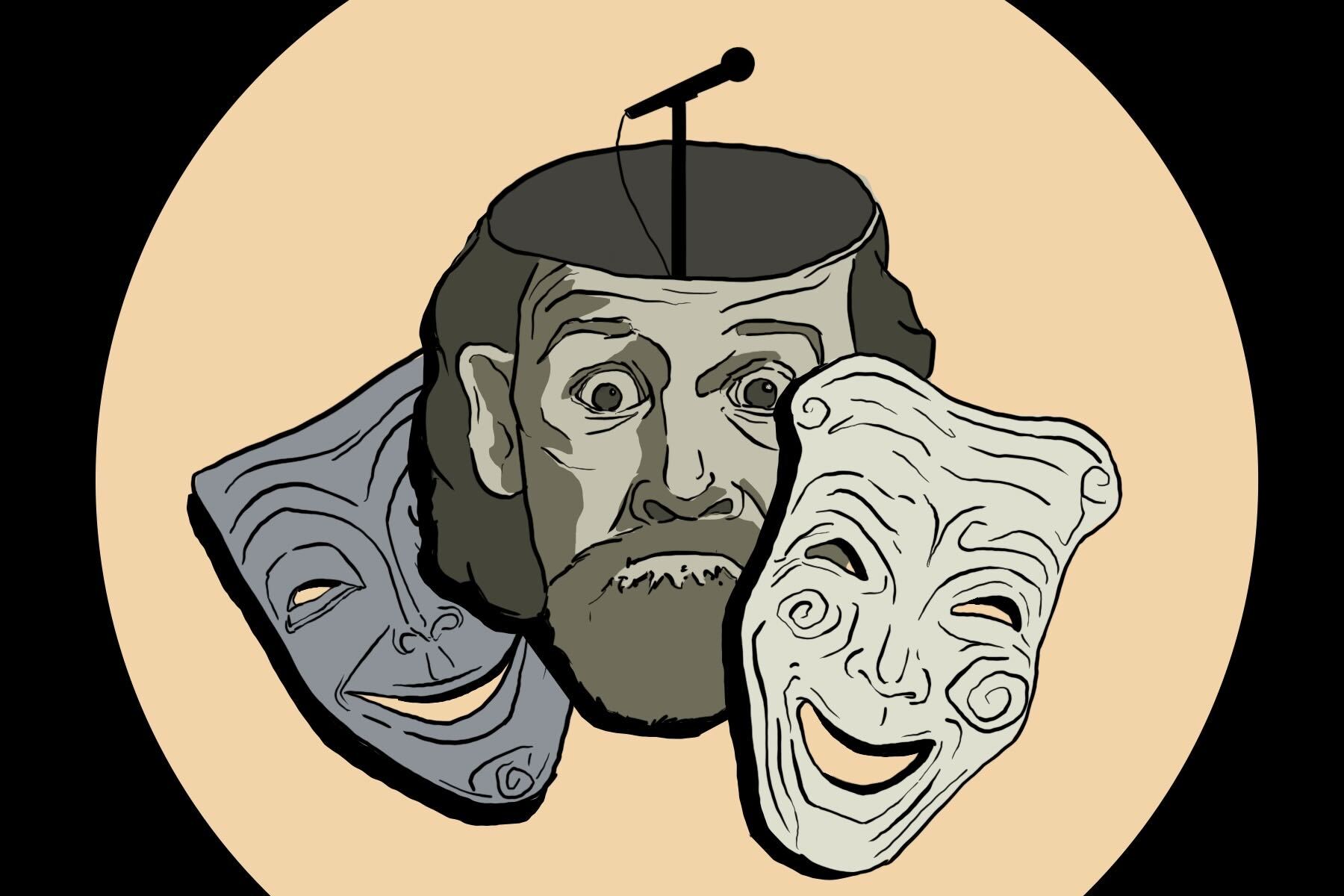Capital punishment in America is one of the most sensitive political and social topics that the nation has wrestled with in the last several decades. A practice that has numerous, complicated applications, it is not a subject matter that many people take lightly. It has touched the lives of many and sparked intense, uncomfortable conversations about how the justice system is used to deal with the nation’s incarcerated population. In other words, it is hard to make people laugh at the death penalty.
Not for George Carlin. The comedian found the topic not only funny, but worthy of a 10-minute bit in his 1996 standup special wherein he outlines his desire to see corrupt bankers and politicians beheaded on national television. The joke is outrageous and grim, yet it is par for the course for Carlin. The beloved standup comedian built his reputation through his provocative yet intellectual brand of comedy, which often focuses on political dysfunction or societal ills. Unlike many comedians who curate comedy routines as shallow spectacles for audience enjoyment, Carlin always sought to draw his audience in as active participants in the show, encouraging them to think about common, everyday ideas from his critical perspective.
Carlin’s comedy career began in 1956, with a repertoire of observational comedy peppered with occasional impersonations. Initially adhering to the conventions of standup comedy, Carlin became wrapped up in the broader countercultural movements of the late 1960s and 1970s, transforming into a figure whose comedy fixated on humorously criticizing institutions of authority and popular media.
While most entertainers become milder with age, Carlin delved even deeper into absurdist critiques in his later career. Throughout his numerous standup specials filmed during the 1990s and 2000s, Carlin relentlessly attacked the United States government, organized religion and corporate society on his crusade of comedy criticism. Throughout his entire career, Carlin had a fascination with linguistics and semantics, especially the way in which the English language is often used in confusing or laughable ways.
Carlin passed away in 2008, leaving a comedy landscape that owes much of its condition to his groundbreaking work. His complex legacy bears examination, which is precisely what one new documentary offers for anyone interested in understanding his singular comedic science.
“George Carlin’s American Dream” is the product of much careful research by directors Michael Bonfiglio and Judd Apatow, who attempt to stitch together a tale of Carlin’s growth as a thought-provoking entertainer. A two-part docuseries hosted on HBO Max, the show captures Carlin’s maturation from traditional stand-up comedian to inventive mouthpiece for the dissatisfied masses.
The documentary starts on an appropriately irreverent note, with the comedian speaking directly to the camera, telling the audience that human rights are nonexistent. There is perhaps no better way to introduce Carlin than by bluntly displaying his willingness to turn even the bleakest thoughts into jokes, but the show quickly offers more structure in the form of several interviews and narrative segments.
The greatest form of flattery is imitation, and the documentary is quick to include the many comedians who have identified Carlin as a primary influence on their works. Chris Rock, Bill Burr, Stephen Colbert and Jerry Seinfeld feature prominently in the documentary, each speaking to the various ways in which Carlin expanded the scope of what standup comedy could cover. Between the interviews and joke segments is a powerful tale of one man’s vision for an elevated comedy, a story that began in Carlin’s earliest days.
In the documentary, Carlin speaks about his early confrontations with authority figures in his life, particularly during his childhood in the Catholic Church. These memories soured his view of organized institutions, though he could not escape them, later joining the Air Force in the 1950s. Carlin quickly left the military to become a radio personality, where he was pigeonholed into a narrow existence by yet another rigid orthodoxy.
Dressed in a suit and styling a slicked-back crew cut, there was nothing edgy about Carlin in his early career. “I remember being very constricted,” Carlin remembers in the documentary. “The fact that I intellectually knew that there was an anal, uptight world out there, and I didn’t feel like I was part of it, didn’t erase the fact that I was a living, breathing example of it.” Soon after experimenting with acid, Carlin began to work more controversial political jokes into his routines, joking about the failed Vietnam War and Muhammad Ali’s draft evasion, receiving broad criticism from the entertainment executives who had given him a platform.
Arguably the most radical change Carlin instated in his career was his frequent use of profanity, which was severely frowned upon in mainstream media. For Carlin, whose ultimate fascination was the usage of language, the inclusion of cursing was his greatest act of revolt against the norms of his industry.
The 1970s saw Carlin dive headfirst into a comedic exploration of traditionally off-limits material. Language took the center stage of this exploration, most famously in the form of his bit covering the “seven words you can never say on television,” which entails a protracted, sarcastic examination of seven examples of profanity. The routine earned him an arrest at a Milwaukee show and was enough to catapult Carlin into the world of comedic superstardom.
The humor of the joke is partially the sheer novelty of a grown man continually reciting a list of curse words but is largely found in the thoughtful deconstruction of the list and Carlin’s examination of why the words are considered improper. He notes that “ass” is an acceptable word in showbusiness when used to describe stupidity but is condemned when used in a sexual context. In a particularly well-received line, Carlin notes that it is acceptable to “prick your finger but not finger your prick.”
The joke serves as a blueprint for what Carlin would continue to do in the next 30 years of his career: get his audiences to think about the comically arbitrary rules that govern society. Language was the most frequently targeted convention, particularly when used in seemingly senseless or ridiculous ways. No phrase or word is too mundane, exemplified by one of Carlin’s more famous outbursts: “Occasional irregularity? What other kind can there be? If it were frequent, it would be regularity!”
While language was Carlin’s ultimate comedic focus and his greatest asset as a creative, the words that comprise his jokes do not fully capture the power of his comedic presence. More than most entertainers of his day, Carlin understood the importance of vocal inflection and bodily animation. He was able to master the art of visual storytelling, using pauses, tone and aggression as well as exaggerated facial expressions to transform a joke into a comprehensive visual experience.
During Carlin’s bit on the seven forbidden words, he mimes the patronizing tone of an adult explaining cursing, and sprinkles in onomatopoeia for a segment where the mimed parent beats the child for reciting the words. Carlin perfected his unique onstage persona during the 1990s, when he used his physical stature as an aging, diminutive man to add a layer of humor to his performances as he paced back and forth spewing jokes with an unusually aggressive delivery. The clips of Carlin’s material in the documentary don’t adequately capture the full spirit of his delivery, yet it offers a glimpse of his mastery of robust, animated comedy.
The documentary’s second part documents Carlin’s second metamorphosis in the 1980s, spurred by several drug incidents and health crises. A turning point in his performance career came in 1982, when Carlin returned to New York to do a taped set at Carnegie Hall. The show was one of his first performances sober and became a key moment for his exploration of semantics when he tested what would soon become one of his most famous bits.
In examining the psychological underpinnings of self-centered consumerism, Carlin exclaims: “That is what life’s about when you think about it: trying to find a place to keep your stuff.” He immediately begins to study the way in which people use language to describe ownership and possession, detailing one’s perspective as a house guest, where: “Someone else’s shit is on the table. Have you noticed that their stuff is shit and your shit is stuff? Get that shit off of there and let me put my stuff down!”
The joke became so successful because it, as Jerry Seinfeld notes in the documentary, constitutes the “elevation of the ordinary and the disassembly of the ordinary.” For Carlin, nothing is ordinary. Any object, person or idea that can be studied will be studied, typically in the form of a protracted joke that tears the subject to shreds.
If the 1980s was Carlin’s decade of transformation, the 1990s and 2000s saw him perfect and immortalize his irreverent craft. With few if any conventions of showbusiness left to violate, he turned his attention toward more comedically articulate deconstructions of institutions and language. It is no coincidence that Carlin’s heightened comedic cynicism came directly after the 1980s, a decade of heightened consumerism and political turmoil, which Carlin describes as “the ascendency of ignorance.”
George Carlin’s material from these two decades is often used as talking points by political figures on both sides, yet Carlin never professed allegiance to any singular party, espousing views in his jokes that could be classified as both conservative and liberal. It is hard to classify Carlin’s ideology in this era, though most of his material from this period lies somewhere between anarchism and nihilism.
Existence itself was often the core of his jokes, best encapsulated by his rhetorical joke: “Life is sacred, who said so? God? Hey, if you read history, you realize that God is one of the leading causes of death. … The sword of God, the blood of the lamb, vengeance is mine — millions of dead motherf—ers.”
As with all his material, one could simply laugh at the contrast of the biblical phrases and his profane conclusion, yet Carlin wants more from the audience. In essence, he is asking the audience to consider how humanity can simultaneously preach nonviolence while perpetually engaging in violence and warfare based upon theological doctrine. In a world that Carlin believed had descended into stupidity, his work became his way of offering a refuge of thoughtfulness for the curious and the disillusioned.
After Carlin’s passing, numerous comedians began to publicly acknowledge the profound influence he had on the trajectory of their careers. Many standup comedians have used the extra creative room that Carlin trailblazed to further elevate the form, incorporating a physicality and precise animation to their routines. Numerous comedians have also followed in Carlin’s footsteps by discussing political topics that were previously seen as off-limits, transforming the dialogue that surrounds these issues. Few entertainers have left ripple effects quite as vast as him, and there is no shortage of Carlin-esque emulation in comedy today. The curtain never really comes down for George Carlin, whose irreverent, vulgar and provocative humor lives on in the voices of comedians everywhere.

















